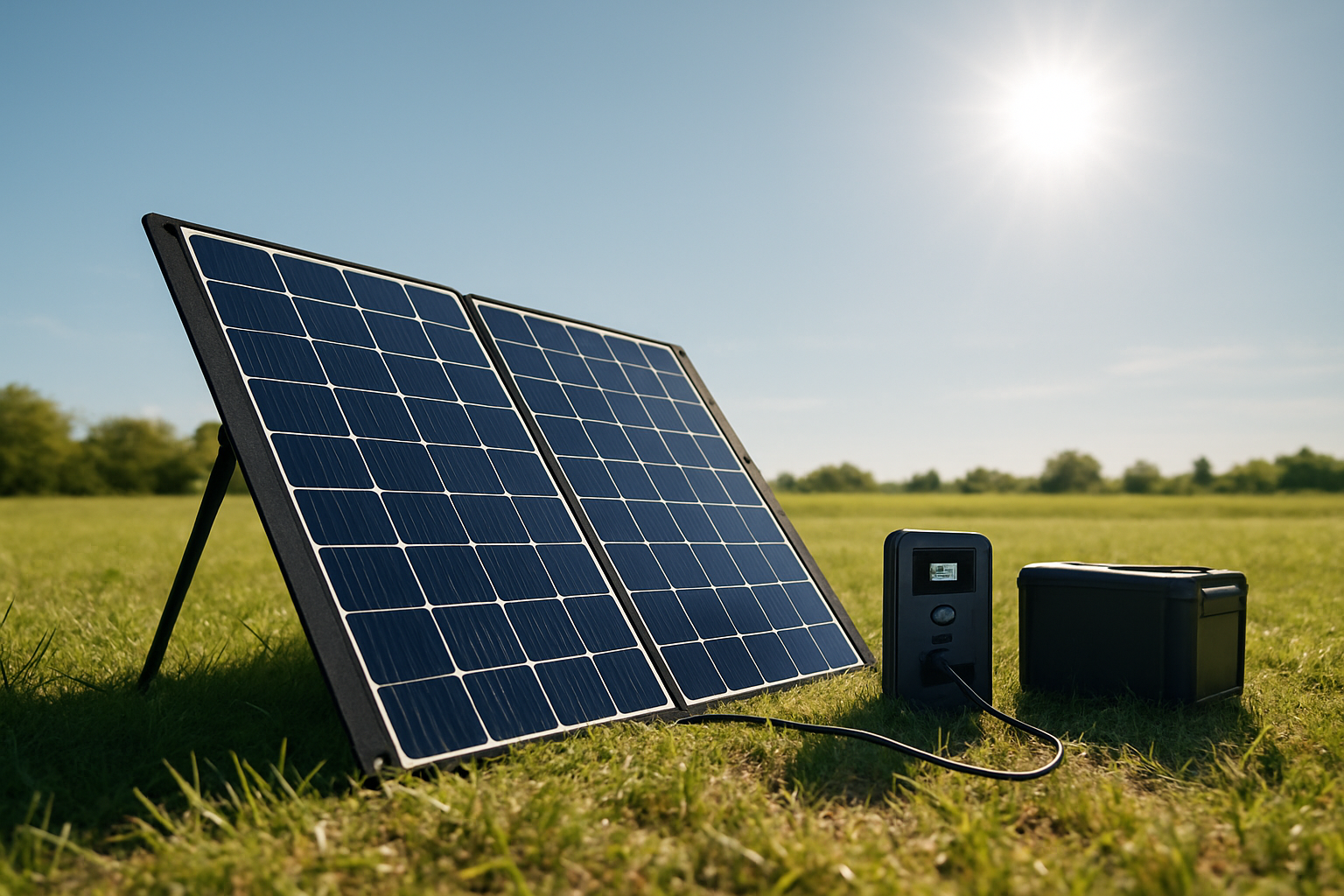Portable solar charging brings real freedom—my field setups have kept radios, phones, and LiFePO₄ packs alive far from the grid. Yet slow charging happens. Below I explain, with data and reproducible checks, why portable solar often underperforms and how to fix it without upsizing everything.
1) The Sun You Get vs. The Sun on the Label
Panel wattage is rated at Standard Test Conditions (STC): 1000 W/m² irradiance and 25 °C cell temperature (AM1.5). Real outdoor conditions rarely match STC, which is why you seldom see “nameplate” power. See the U.S. Department of Energy overview and STC definition for context: DOE PV performance guide;STC basics.
Quick math you can repeat
If plane-of-array irradiance is ~650 W/m² at noon (thin haze), a “100 W” panel can only deliver about 65 W before other losses. That alone explains many “it’s sunny, but still slow” reports.
Orientation and Partial Shading
Panels peak when the sun hits them close to perpendicular; off-angle placement or even small shadows from straps/branches can collapse string current. Bypass diodes help, but partial shade still creates multiple power peaks that basic controllers may miss; see MPPT fundamentals: MPPT overview.
2) Heat: The Quiet Power Thief
Crystalline silicon modules lose power as they heat up (negative temperature coefficient typically around 0.3–0.5%/°C). Midday on a dark surface, module temperature can sit 20–35 °C above air temperature. Sandia’s temperature models quantify this rise for outdoor modules: Sandia module temperature model. Practical takeaway: if cell temperature is ~45 °C, expect roughly 6–10% less power than at 25 °C.
3) Air & Surfaces: Clouds, Haze, and Soiling
Haze scatters light; clouds can cut output by 50–80%. Dust, pollen, and sea salt form a film that reduces transmittance. Multi-region research summarizes soiling losses from single digits to >15% depending on climate and interval; see NREL soiling study (~16.5% loss case),and the international review by IEA-PVPS: Soiling losses report. Regular, gentle cleaning of portable panels is worth it.
4) The Electrical Path: Wires, Connectors, Controller
Cable Gauge and Run Length
Undersized or long leads cause voltage drop. I aim to keep round-trip DC drop <3% for portable rigs. As a rule of thumb, halving resistance (e.g., moving from AWG 16 to AWG 12 on the same length) nearly halves that loss. Loose or corroded connectors add intermittent milliohms that heat up and waste watts—inspect and reseat often.
Controller Choice and Behavior
Maximum Power Point Tracking (MPPT) controllers convert surplus panel voltage into current and usually deliver more energy than PWM, especially in cool weather or when Vmp ≫ battery voltage. Literature commonly reports double-digit gains; see technique overviews and recent comparative studies: MPPT concept;2025 review of MPPT methods.
5) Batteries: Why the Last 15–20% Feels Slow
Most Li-ion chemistries (including LiFePO₄) use CC/CV charging: high current until target voltage, then a taper. Near full, internal resistance and charger logic reduce current to a few percent of capacity; this is healthy but looks “slow.” See charging profiles: Battery University on CC/CV.
Field note
On a 12 V-100 Ah LiFePO₄ pack with a 100 W panel and MPPT, I often see ~5–6 A in bright, cool sun early in the cycle; as SoC crosses ~85–90%, taper can drop below 2 A even with unchanged irradiance—this is expected.
6) Aging and Maintenance
Panels degrade slowly (often <1%/year), but connectors, charge ports, and folding hinges on portable kits take much harder knocks. Most of the “sudden slowdowns” I audit trace to a single high-resistance point (oxidized plug, bent pin, or a nicked cable). A 60-second checklist below catches the common culprits.
60-Second Diagnostic Checklist
- Midday tilt toward the sun; eliminate micro-shadows (straps, cables).
- Measure open-circuit voltage and short-circuit current against the datasheet at similar sun.
- Confirm controller type and settings (battery chemistry, absorption/float limits).
- Check connector temperature by touch—warm equals resistive loss; reseat/replace.
- Verify wire gauge vs. length; target <3% round-trip voltage drop.
- Clean panel surface; if coastal/dusty, shorten cleaning interval.
- Watch battery current near full—taper is normal; judge speed earlier in the cycle.
Frequently Asked Questions
Why is it slow even on a sunny day?
Because “sunny” ≠ STC. Irradiance may be 600–800 W/m², cells may be hot (-6–10%), and any mis-tilt or tiny shadow hurts. Start with irradiance/temperature reality and cable drop.
How big is the temperature hit?
Typical loss ~0.3–0.5%/°C above 25 °C cell temperature. With cells at ~45 °C, expect ~6–10% less than the nameplate. See modeling guidance: Sandia.
Do MPPT controllers always help?
They can’t invent sunlight, but in mismatched voltage or cool/variable conditions, MPPT usually recovers double-digit percentage gains over PWM. See concept and comparative reviews: MPPT concept;comparative study.
How often should I clean portable panels?
Visually inspect each outing; in dusty/salty areas, wipe before and after trips. Research shows soiling can reach double-digit losses if neglected: NREL case;IEA-PVPS review.
References & Data Sources (Neutral/Authoritative)
- DOE: Understanding Solar Photovoltaic System Performance
- PVsyst: Standard Test Conditions
- Sandia PV Performance Modeling Collaborative: Module Temperature Model
- NREL: Impact of Soiling on PV Modules
- IEA-PVPS: Soiling Losses – Global Report
- Battery University: Charging Lithium-ion (CC/CV & taper)
- MPPT concept (general overview);2025 MPPT methods study
Disclaimer
This material is educational and reflects my field observations plus public sources. Validate settings against your specific hardware documentation.





Leave a comment
All comments are moderated before being published.
This site is protected by hCaptcha and the hCaptcha Privacy Policy and Terms of Service apply.